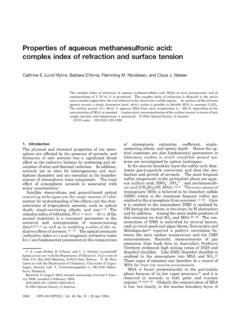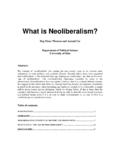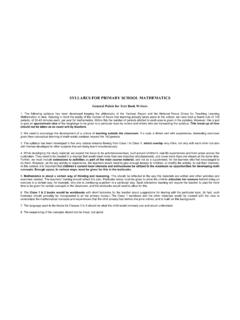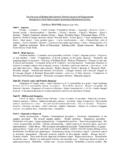Transcription of Symmetry-operations, point groups, space groups and ...
1 1. symmetry - operations , point groups , space groups and crystal structure KJ/MV 210. Helmer Fjellv g, Department of Chemistry, University of Oslo 1994. This compendium replaces chapter and 6 in West. Sections not part of the curriculum are enclosed in asterisks (*). It is recommended that the textbooks of West and Jastrzebski are used as supplementary reading material, with special emphasis on illustrative examples. In this compendium illustrative examples (in italics) have been chosen from close packed structures. A few symbols and synonyms are given in Norwegian as information. The compendium contains exercises which will not be explained in the classes. It is recommended to work through the exercises while reading this compendium.
2 Introduction. Condensed phases may be liquids as well as solids. There are fundamental differences between liquids and solids regarding the long-range distribution of atoms. While liquids have long range disorder in a large scale, solids are mainly ordered, there is regularity in the repetition of structural fragments (atoms and/or groups of atoms) in the 3 dimensional material. Surfaces of solid materials are often somewhat differently organized than the bulk . ( the inner part of the material). The atomic (structural) arrangement near the surface will often be different from the bulk arrangement due to surface reconstruction in order to minimize the energy loss associated with complete chemical bonding in all actual directions.
3 Liquids are disordered in bulk, but they often have an ordered surface structure. Solids do not need to display systematic long-range order, to be crystalline. Some phases can be prepared as amorphous materials, glasses. They may be made crystallized by a suitable temperature treatment. A few phases exist which are only known in an amorphous state. In order to simplify the description of symmetry relations in atomic arrangements ( the appearance of a structure fragment, molecule or complex) symmetry operations are used. symmetry - operations like mirroring and rotation are known from every-day-life. If one wishes to describe how structure fragments are repeated (translated) through a solid compound, symmetry - operations which include translation must be used in addition.
4 symmetry -descriptions of given isolated objects are also known from every-day-life, a lump of sugar, a dice, a wheel (with an n-fold rotation axes for n spokes equally distributed). or a pyramid (with four-fold rotation axis perpendicular to the basis plan). 2. This compendium does not intend to give complete introduction to the basics of symmetry descriptions of solids. That is not the objective of this part of KJ-MV 210. The text is not written in order to give the reader a perfect and full understanding of crystallography. Instead it will give a simplified picture of the field. The intension of the compendium is to provide a basic knowledge of central issues, so that the reader will be able to draw different structures based on published structural data and available references (International Tables of Crystallography).
5 This will be very useful in later courses concerned with properties of inorganic materials. It is important to realise that there is a close connection between atomic arrangements (structure, chemical bonding) and chemical and physical properties. The chosen examples in the compendium are related to close packing of atoms. The reader is recommended to carefully work through the examples. The unit cell. In the crystalline state there are rules for how structural elements are repeated through the solid. One can identify structural fragments that form the smallest repeating units; by repeating these in 3 dimensions they build the whole material. One can think of the smallest repeating unit as described inside a box.
6 By stacking of the boxes in 3 dimensions a complete description of the structure of the solid material is obtained. Such a box is called a unit cell (enhetscelle). The box is defined by 3 vectors, t1, t2 and t3 [with unit cell volume V = t1 (t2 x t3)]. The vectors are not necessarily orthogonal. As a starting point there are no conditions on the 3 angles between the vectors, , and . ( they are not restricted in any way, to be 90 ). When describing the structure of a solid material in the scientific literature, relevant data for the crystallographic unit cell are given. The unit cell is given by the length of the three axes, a, b and c (unit cell dimensions, unit cell parameters, cell edges; the lengths of the vectors t1, t2 and t3) and the angles , and.
7 Definition of the angles relative to the axes (t1, t2 and t3. or equivalent a, b and c) is shown in Figure 1. In order to describe the atomic arrangement, one has in addition to defining the shape of the unit cell and also to state where the atoms are in the repeating unit cell. This is done by giving the position of the atoms as coordinates (x,y,z). The atomic coordinates are given as fractions of the unit length of the vectors. Thus position (0,0,0) is the origo of the unit cell, while the point (1,0,0) is moved (t1,0,0), one cell edge along the a-axis parallel to t1. An atom in the corner of the unit cell therefore has the coordinates (0,0,0), while an atom on the centre of the a-axis has the coordinates (1/2,0,0).
8 As a principal rule, any given atom can be transferred to one or more atoms, of the same type and with the same surroundings, within the unit cell by symmetry operations . In order to describe all the atoms in the unit cell it is enough to give the coordinates of a certain part of the atoms along with the necessary symmetry operations . Within a unit cell one often find several atoms of the same kind. If the surroundings of these atoms are identical, the atoms are related by symmetry operations (they are crystallographic equivalent atoms). If the surroundings are more or less different, the difference is signified by using different notations for the atoms, Cu(1) and Cu(2), where the number in brackets is just numbering of the same type of element.
9 In such cases one would say that Cu(1) and Cu(2). are not crystallographic equivalent atoms. 3. Figure 1. The definition of relations between angles and axes in unit cells. The unit cell is shown as the box on the left. Example 1 (2-dimensional unit cell). A number of simple structures, for metals and alloys, may be derived from close packing of spheres. Here the atoms are thought to be ideal, non compressible spheres of the same size. Before we look at such 3-dimensional structures in details, we will take a closer look at how symmetry -notation can be used to describe close packing in 2-dimensions. Then we will add different symmetry operations , still looking at the 2- dimensional model of the structure.
10 Consider a 2-dimensional close packing of identical spheres. The spheres are placed as close as possible ( with the least possible space between them). This is shown to the left below. Let us now define a 2-dimensional unit cell for the pattern of repeating spheres. We choose the centre of sphere A as origo. (You will get the same unit cell with any other choice of origo, but there will be less symmetry around the origo). The direction and length of the translation vectors (cell edges) must first be determined. Let t1 be the vector from the centre of sphere A to the centre of sphere 4, and let t2 be the vector form the centre of sphere A to the centre of sphere 2. The unit cell is completed by translating t2 so that it starts in the centre of sphere 4 and t1 to start in the centre of sphere 2.











